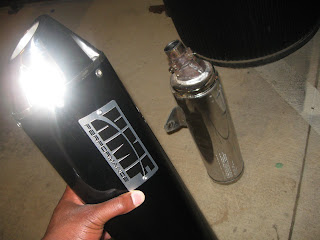For some reason I feel I have to do a disclaimer beforehand, because I have a feeling somebody's going to follow my step-by-step instructions on how to install their new exhaust. But, by all means, use this method if you like...afterall, it did work! And the bottom line is....it's just a slip-on!
But this is mainly for people interested in doing business with HMF Racing, or considering a new exhaust; I pretty much want to detail all the questions I had going into this, and where I found, or didn't find, the answers, and how this process went. Before purchasing, I did all this research to seek out answers and granted I did find most from searching forums, a lot of people weren't as detailed with their answers.
Dealing with HMF Racing Let me start by saying I ordered direct from HMF Racing on Tuesday October 13th, and it was in my hands that Monday October 19th. Talk about fast shipping!!! They weren't kidding. And I live out in rural Texas (albeit, it's a college campus), so I imagine if you live near a major city center, then it would arrive even faster than that. On the other hand, they are absolutely
BRUTAL with answering email! There is no lighter way to put it. Like I mentioned above, I found a lot of the information from message boards, and forums, but just for piece of mind, I kind of wanted to hear it directly from the dealer. But I know as a consumer, nothing is like a well-written, honest, unbiased, user review! I first heard of this brand of exhaust from reading
http://kawiforums.com/, and decided to check it out, and browse their site. I was lurking the HMF site for over 1 month, and then I suddenly noticed they were having a sale, so I jumped on it. I compared prices to all the other Exhaust makers, and it seems like HMF was the right way to go considering my budget. My price was $227 -- which included the exhaust can, and the end-cap; arguably the best deal on any slip-on exhaust out there! Do the research... With that said, I have to give them a
8/10 just because they are horrible with email (some of my questions still have yet to be responded to), but they get extra clout because of the outstanding price, and unbelievable shipping time.
Benito and I with the goods, fresh out the box
Picture of the stock exhaust

Removing Stock Exhaust
Close-up of the stock exhaust. FYI, taking off the stock parts are a cinch. It comes off in two parts; the heat shield, and the exhaust can itself. All you have to do is literally twist/pull it off. Comes off fairly easy with little-moderate effort.
The HMF cans' lead pipe goes over the bike's exhaust, up until the point with it is ridged in the picture. That is approximate 3-4 inches before it reaches its endpoint.

I'd truly say the hardest part about removing the stock exhaust was twisting my semi-but-not-quite-dull Allen wrench on the two (2) smaller screws Lauren is holding. You may have a better experience than I did. They are positioned atop of eachother, and I removed the top one - no problem, but I nearly stripped the second of the screws. That is when I called in Benito, and luckily, he didn't care and just poweredrove that bitch off. No second guessing! I was all careful and ish because I didn't want to strip the screw, and then have the sh*t stuck on there.

Close up of heatshield and the screws that come off the heatshield, also the longer bolt that attaches at the rear footpeg, which is the mount for the stock exhaust. According to HMF, you can use the original parts with the new exhaust, and it will work just fine. I agree, the new parts they send, are identical and may be desired over the old ones, because they look newer and shinier.

Installation of HMF can
Naked. No can. This was a lot harder than I thought it would be. I'll be honest, I had the WD-40 all ready to go because I had a feeling it wasn't going to cooperate; and I learned that from reading others and their experience with this part. Initially, the HMF can goes on, so you feel good about yourself, then it hits a wall. We brought in the WD-40, sprayed lightly around the edges, and inside the can, and after about 3 trial-and errors, switching positions, and using knees and elbows, arms, etc. to try and get it on, we gave it a 3rd coat of WD-40 and Ben got that b!tch on! Whew, I was relieved. I knew it would eventually get on, but it took a good effort to get it there.
In that process, I think we may have threw off the angle of the exhaust pipe because once hte HMF can was on, nothing was aligned right, and we have to "force" the can back into an acceptable position so it would sit where it could be attached to the rearpegs where the stock exhaust sat. This process too a little over 20 minutes alone; mainly because we couldn't really figure out which part went where and so forth.
At this point, I went back online and looked at how other guys mounted their cans, and how they attached their heatshields. Nothing they did seemed to be working with mine. So, Ben and I got creative, and improvised. This is point where I say, you can either "do as I did, or not!" You will be able to see in the following two pictures, we didn't install the heat shield, which nullified the need for a lot of the screws/parts. In the shots, you can see the actualy pipe is exposed. Installation
5/10 because the instructions weren't helpful at all, but in actuality, you don't need them, however, at some points you may have questions but the instructions pretty much say, "remove old exhaust, twist on new one. May require some effort."

Exposed pipe
Ready for a test run.
In the video, you can hear the finished product. Yes, it blows me away how different the bike sounds from the stock exhaust. The sound is incredibly deep and full, and shakes the entire parking garage!
Overall, I am more than satisfied with the product and how the outcome. It was difficult at first, but I truly think anyone can perform this modification. it just takes patience, and a little over 1 hour for the complete process. HMF supplies you with everything you need, except a wrench/pliers, slightly larger allen wrench to remove stock exhaust, and maybe some WD-40 to assist with the twisting and pushing of the new can onto the pipe. If you're not sure what type of company you're going to go with, just keep researching until you know.
And for the most requested question I had, and what you probably have, is "did I rejet the carbs, or shim the carb needles?" and the answer is, "No." Do I plan to? The answer is "No." HMF doesn't require it, although I think they recommend it. But most people, I find, fall into the convincing tone of everyone saying to jet your carbs, or whatnot. The problem I find with that is, most people are complaining of backfire when slowing from high RPMs to low RPMs. I am not experiencing the backfire, as a lot of other folks aren't, but if you are the unfortunate one who had TOO MUCH backfire, and want to get rid of it, then rejetting is suggested for that. From doing my research and reading up on that subject, some backfire isn't bad, therefore, a lot of people are oversenstizing this issue, and spending additional money on jetkits that they don't necessarily have to.
Hope this helps, and feel free to leave questions












1 comment:
thanks for the blog. i used yours and many other videos to decide on buying a slip hmf. it comes tomorrow and i am thinking about using a torch and ice to expand the metal to help it slide of better. hopefully it works.
Post a Comment